[Editor’s Note: After Mother’s Day, florists must be taking the day off. So how many of the blooming plants are actually edible? Crunchy Mama (See her full bio below) gives us a detailed analysis of a popular plant that you may have in your yard that’s pretty and nutritious. I hope you enjoy the second post in her Wild Food Series here on our blog. Leave her some feedback please.]
Reprinted with permission from Crunchy Mama’s Urban Homestead.
Gorgeous, Delicious and Nutritious Violets! My Wild Food Adventures Series
BY THECRUNCHYMAMACHRONICLES
I’ve said that ostrich fern shoots are my favorite wild edible but violets are a super-close second. They are so lovely! On my property, I have lots of Viola odorata.
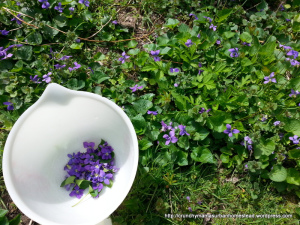
The young leaves are mild and great in salads. The flowers are mild-tasting with a hint of sweetness; you can just pluck and eat or gather some for a beautiful addition to your salad or sprinkle on your cooked and plated food.
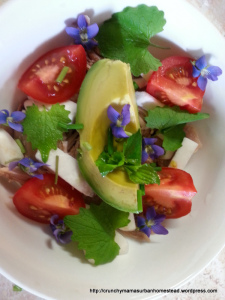
In this photo, I have a base of cut-up turnips topped with an avocado slice, tomato slices, garlic mustard leaves, and violet flowers and young leaves.
Here are some close-up photos that I took:
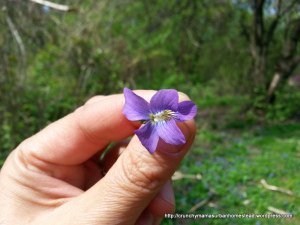
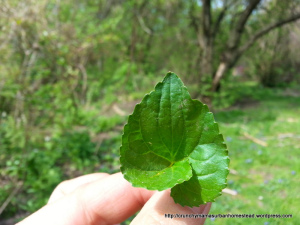
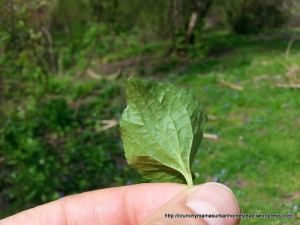
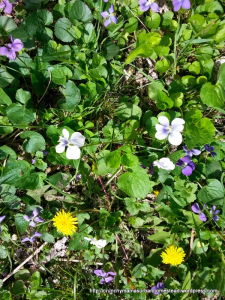
In this photo, you see a violet plant growing all by itself and so I just used some scissors to harvest the leaves. 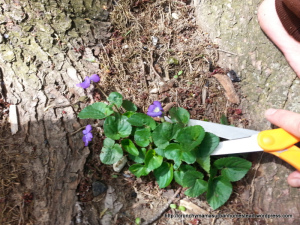
Here is the itemization of the violet:
Identifying Features:
Flowers have 5 petals in a butterfly shape. They grow as a single flower at the end of the stem. There is a sharp bend where the flower and the stem join.
Leaves are heart-shaped; the sides often curl toward the juncture of the stem and the leaf.
Roots are fibrous and are NOT edible and actually toxic according to Teresa Marrone.
Time of Year: mid-spring to early-summer for the flowers and leaves (before they become tough from the summer heat)
Environment: Preferably moist soil with some shade.
Method of Preparation: You can eat the flowers and young leaves (lighter green) raw. You can also cook the young leaves as well as older leaves as you would spinach.
Medicinal uses? Yes! Two Herbal Mamas has a video on how to make an oil infusion with violets. And on their blog they have a post which lists the medicinal qualities of the plant: “Violet…contains saponins, salicylates, alkaloids, flavonoides and volatile oils. The actions of this shy plant are anti-inflammatory, expectorant, diuretic, anti-rheumatic, laxative and stabilizes capillary membranes. Violet contains an enormous amount of Vitamin A. Chew on a violet leaf and spit it out on to your hand. Give the leaf a good rub. You will feel the slippery mucilage contained in this powerful plant. Mucilaginous herbs are moist, and soothe skin ailments and internal mucous surfaces.”
Poisonous look-alikes? Larkspur and Monkshood– there blooms look similar perhaps to an untrained eye but you can absolutely tell the difference between them and violets in short order.
The larkspur bloom has a long spur on the rear of the bloom. There are good photos here. The leaves are very different as well. And, lastly, there are multiple blooms coming from one stem (unlike the violet which is one bloom on the end of the stem).
There are some good photos and information on monkshood here. Again, the leaves are very different from violet leaves; monkshood leaves are palmate while violet leaves are heart-shaped. While the blooms can be the same color as violets AND have 5 petals they are shaped differently. According to the Wikipedia link at the beginning of this paragraph, “[the flowers] are distinguishable by having one of the five petaloid sepals (the posterior one), called the galea, in the form of a cylindrical helmet; hence the English name monkshood.”
According to Abundantly Wild by Teresa Marrone, you would be wise to collect violet leaves only when the plant is in bloom because the leaves can resemble some poisonous plant leaves. When the plant is in bloom, it will be easy for you to recognize and gather the correct leaves.
As with anything that you put in your mouth, you need to properly identify the plant. Here are more resources on properly identifying and eating violets:
Eating Violets by The Urban Forager (Ava Chin);
Wild Man Steve Brill (great illustrations and close-up photos);
Elias and Dykeman’s Edible Wild Plants: A North American Field Guide (pages 95, 96, 116);
Abundantly Wild by Teresa Marrone;
Edible and Medicinal Plants of the Great Lakes Region by Thomas A. Naegele
Author bio: The Crunchy Mama is a libertarian unschooling mama to three sons, married to her husband since 1998. They live on their Midwestern homestead of 2 ½ acres with chickens, ducks, dogs and an ever-growing organic vegetable garden. She is an avid wild food eater. In general, she’d rather be outside enjoying creation. She can be followed on Twitter @thecrunchymama or on her blog Crunchy Mama’s Urban Homestead.




